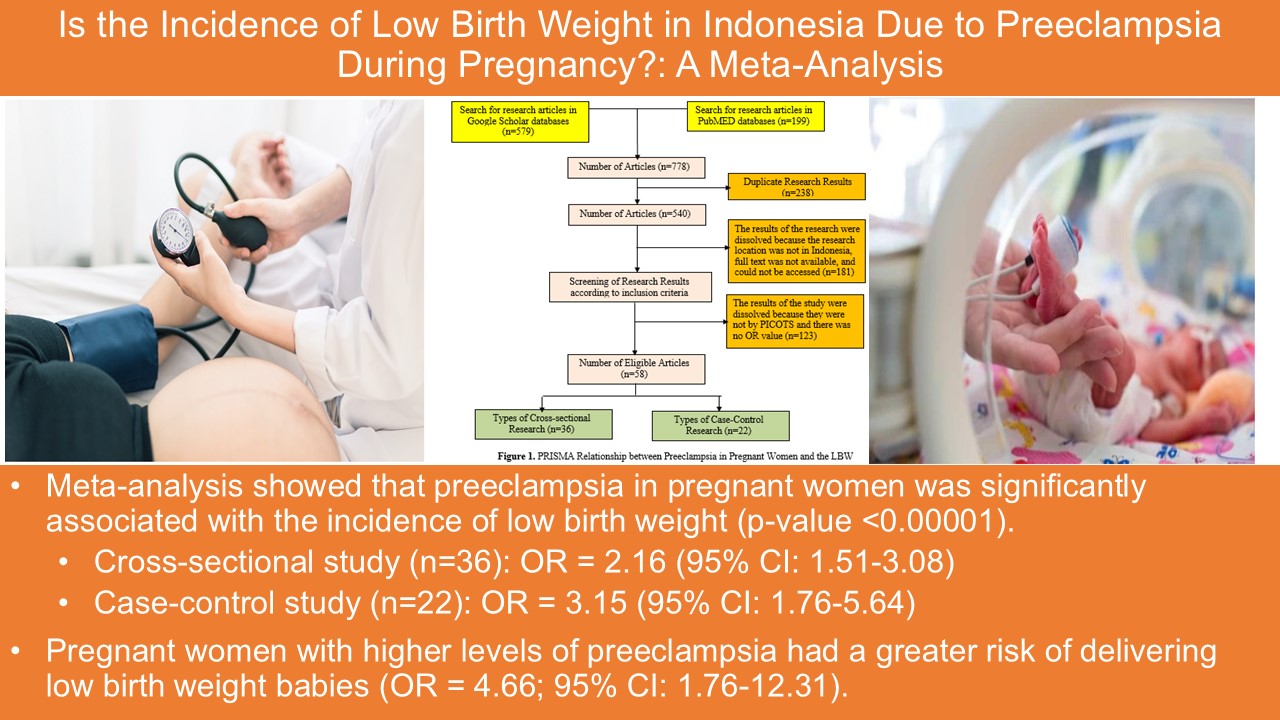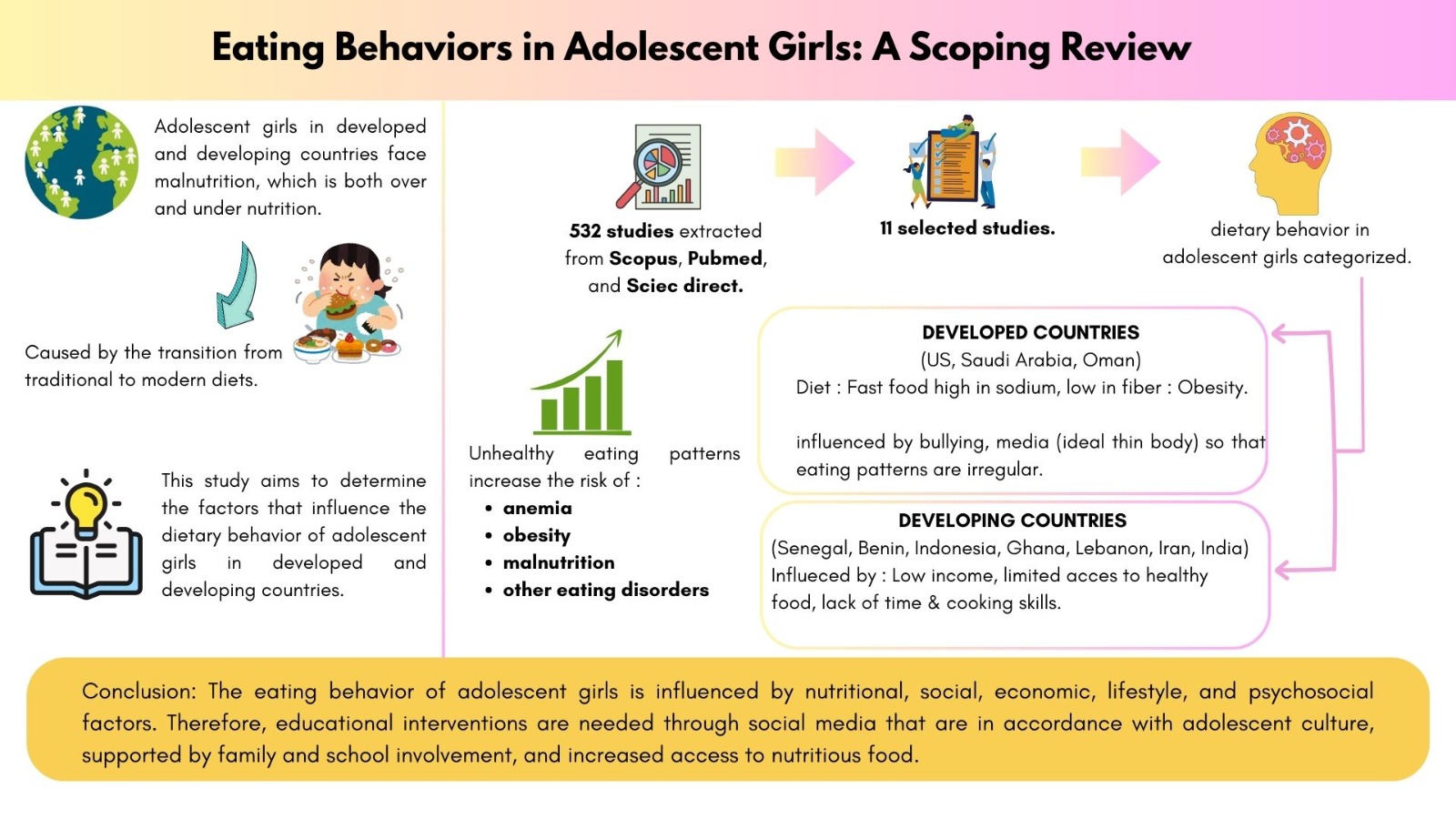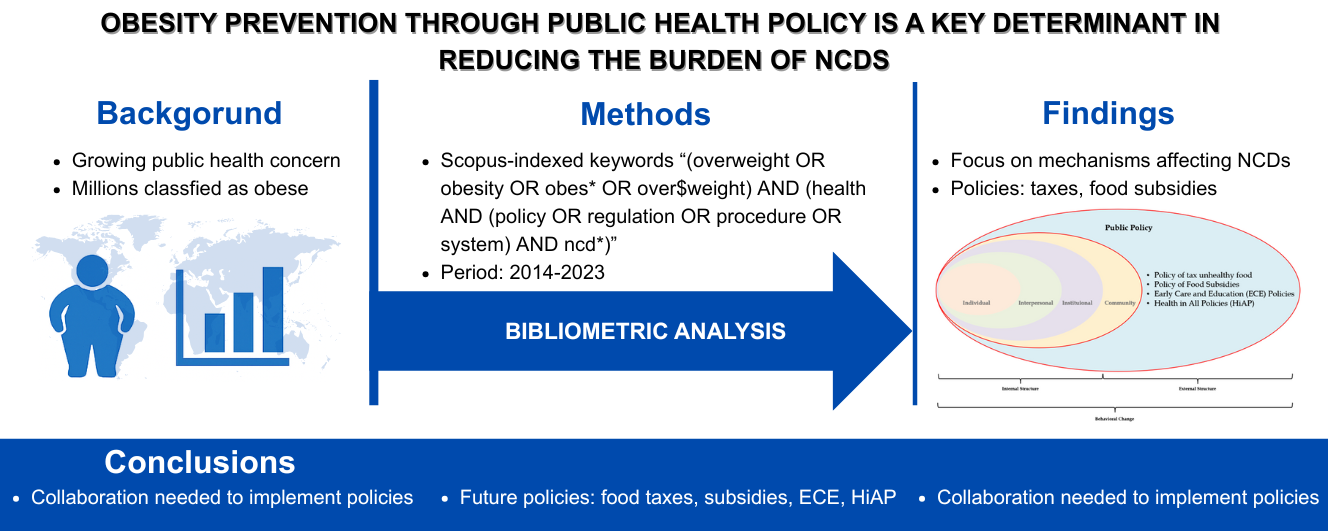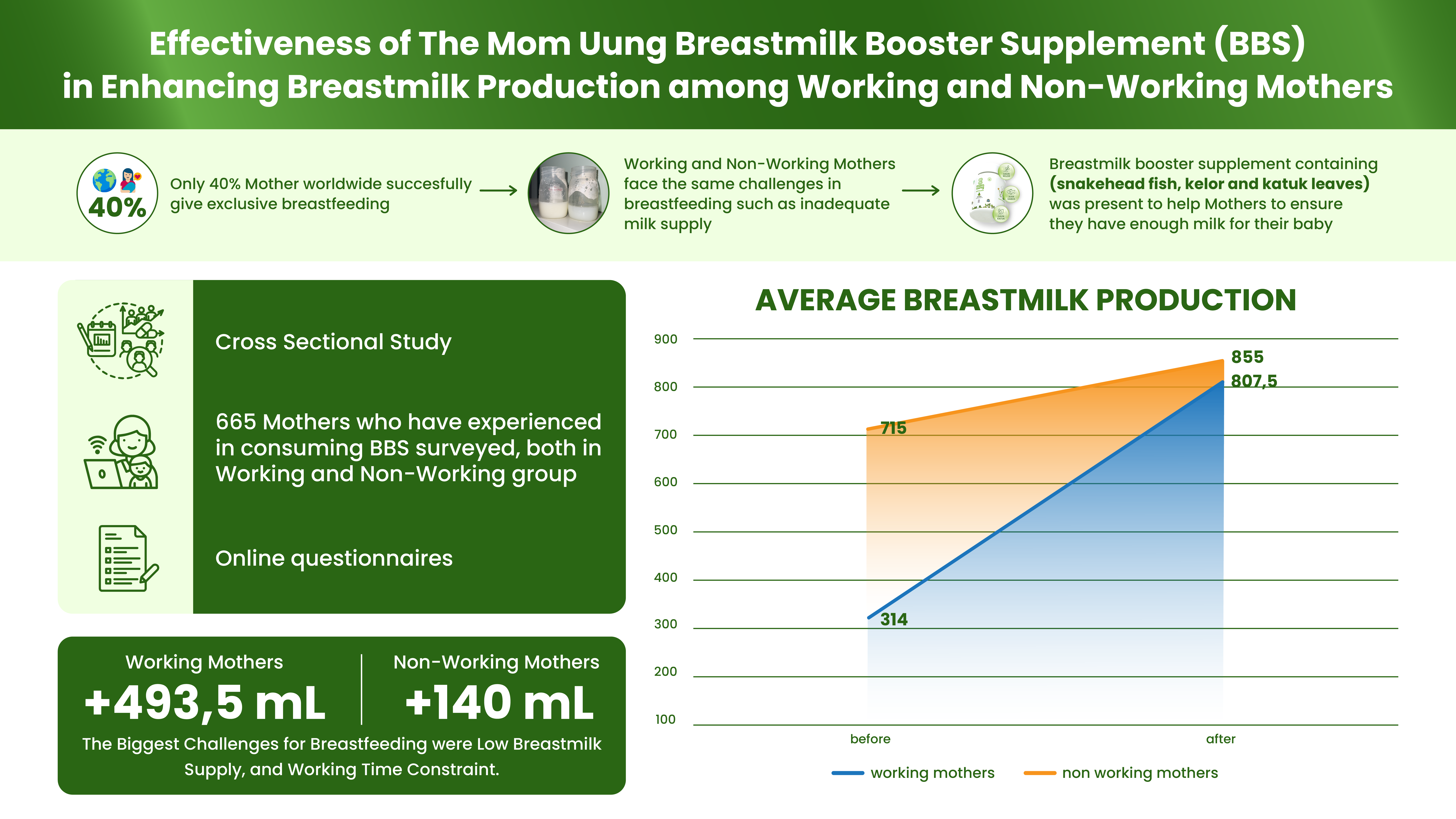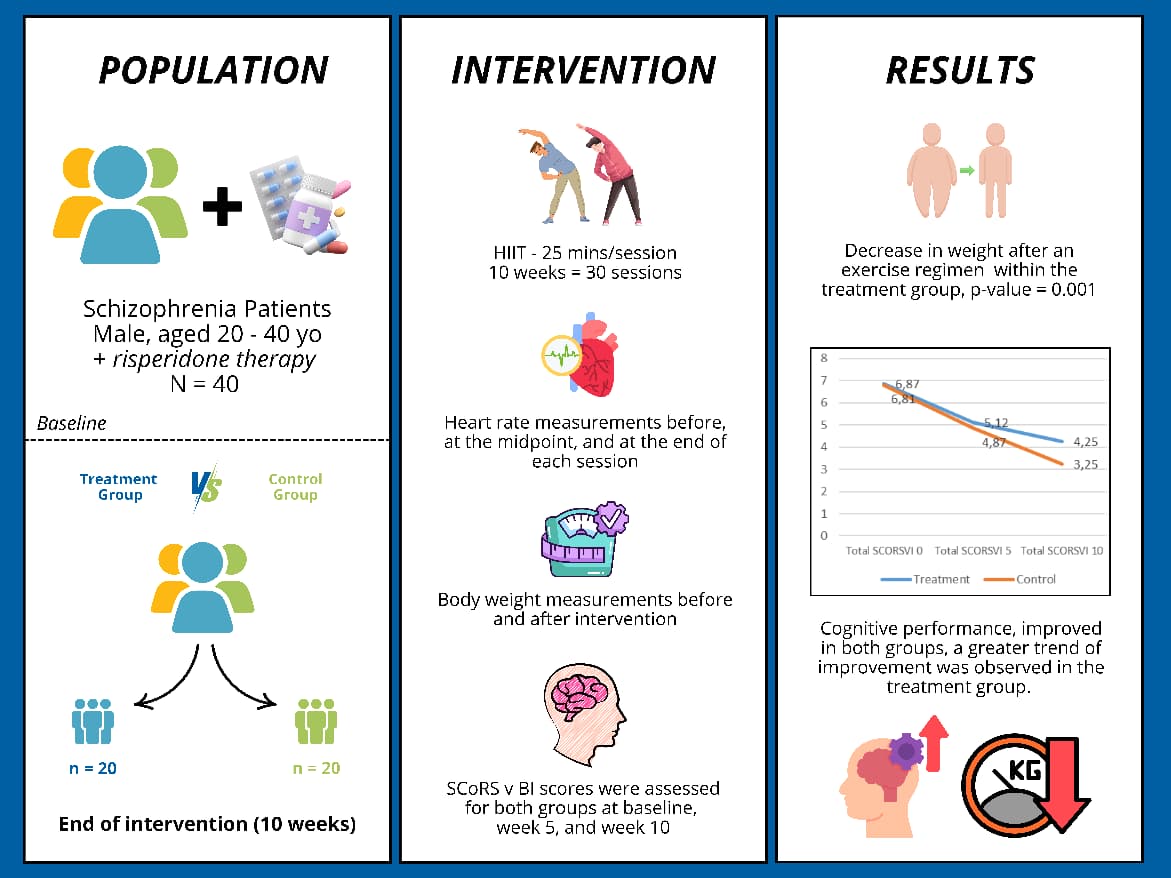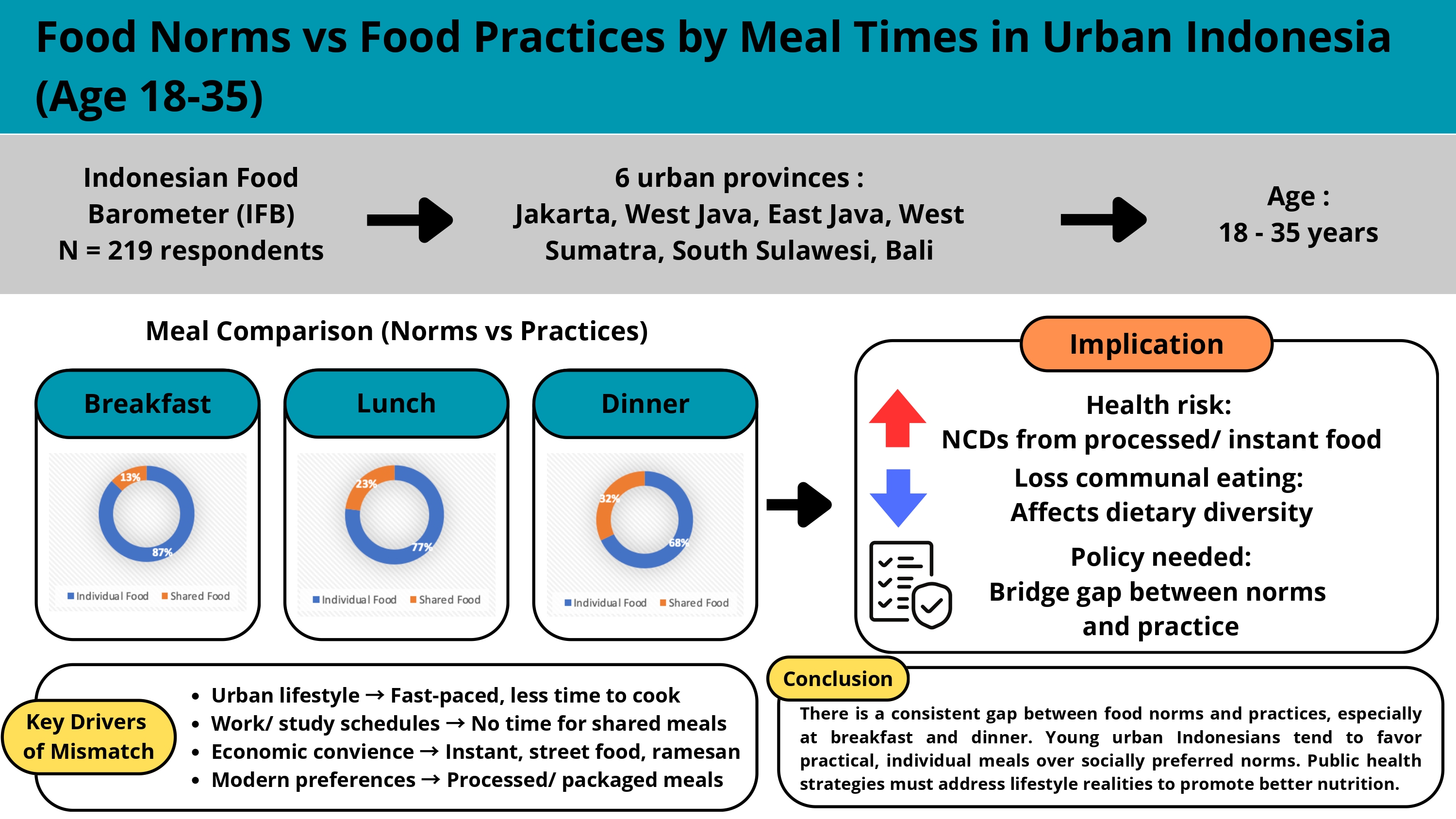ADOLESCENT MENTAL HEALTH AND LIFESTYLE CHANGES: EXPLORING EATING DISORDERS AND PHYSICAL ACTIVITY DURING COVID-19
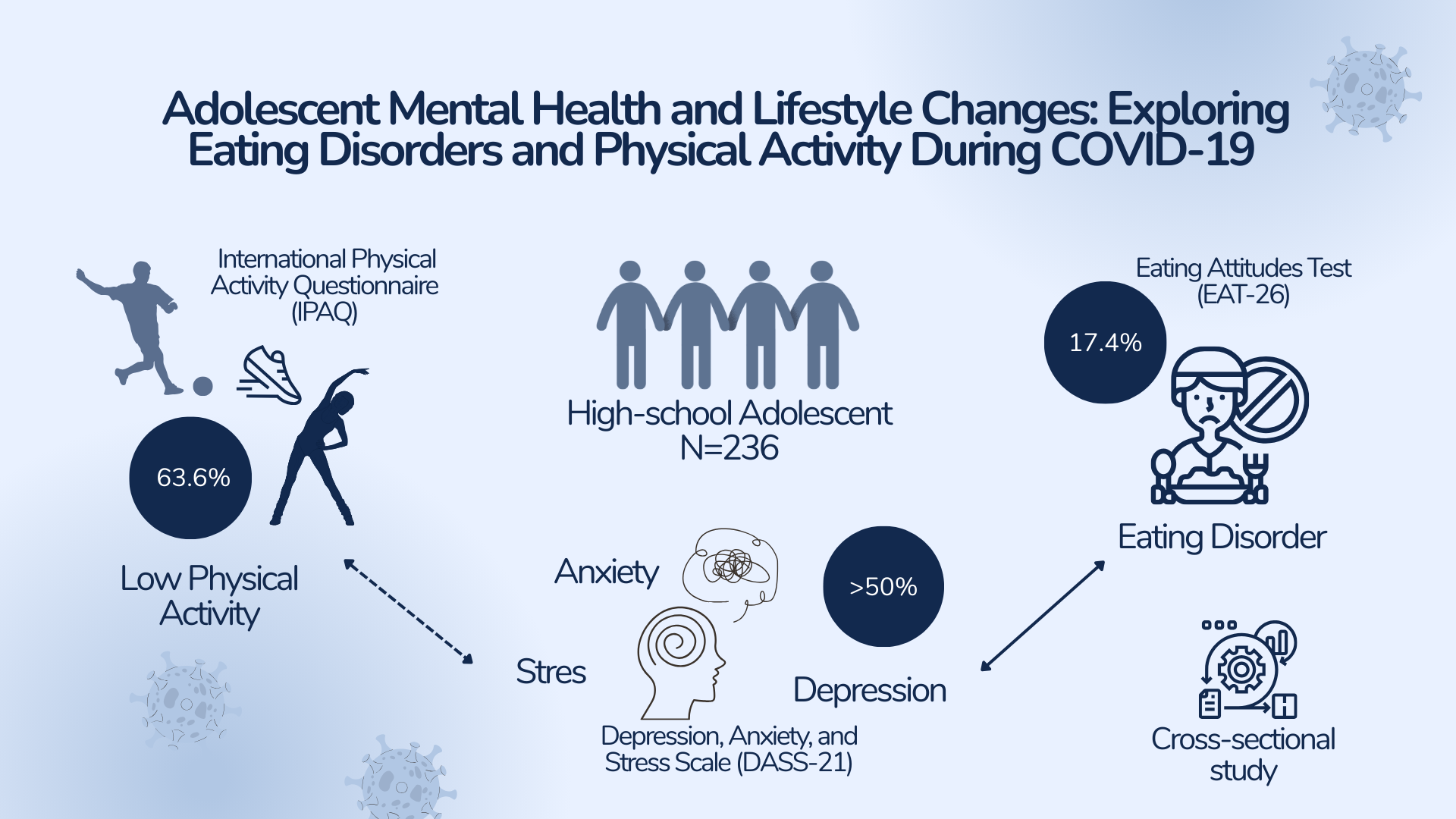
Downloads
Background: Mental health, diet, and physical activity play an important role in adolescents development. However, previous studies have reported inconsistent findings on the relationship between mental health, eating disorders, and physical activity. The COVID-19 pandemic has negatively impacted mental health, potentially contributing to eating disorders and reducing physical activity. Objectives: This study aimed to examine the association between mental health, eating disorders, and physical activity in adolescents during the COVID-19 pandemic. Methods: A cross sectional quantitative study was conducted in 2022, involving 236 high school adolescents. Mental health was assessed using the Depression, Anxiety, and Stress Scale (DASS-21), eating disorders were evaluate with the Eating Attitudes Test (EAT-26), and physical activity levels were measured using the International Physical Activity Questionnaire (IPAQ). Results: More than 50% of adolescents experienced depression, anxiety, or stress with severity ranging from mild to very severe. While 82.6% of adolescents did not exhibit eating disorders, 63.6% had low physical activity levels. A significant association was found between depression and eating disorders (p=0.024), but no significant relationship was observed between anxiety (p=0.080) or stress (p=0.232) and eating disorders. Additionally, depression (p=0.411), anxiety (p=0.547) and stress (p=0.097) were not significantly associated with physical activity. Conclusion: During the COVID-19 pandemic, most adolescents experinced mental health challenges, maintened normal eating behaviors, and exhibited low physical activity. Depression was significantly correlated with eating disorders, while no significant associations were found between mental health variables and physical activity levels.
World Health Organization (WHO). Mental health of adolescents. World Health Organization (WHO) https://www.who.int/news-room/fact-sheets/detail/adolescent-mental-health (2024).
Madigan, S. et al. Changes in Depression and Anxiety Among Children and Adolescents From Before to During the COVID-19 Pandemic: A Systematic Review and Meta-analysis. JAMA Pediatr. 177, 567–581 (2023).
Đorđić, V. et al. Physical Activity, Eating Habits and Mental Health during COVID-19 Lockdown Period in Serbian Adolescents. Healthc. (Basel, Switzerland) 10, (2022).
Touyz, S., Lacey, H. & Hay, P. Eating disorders in the time of COVID-19. J. Eat. Disord. 8, 19 (2020).
Brown, S. M. et al. A qualitative exploration of the impact of COVID-19 on individuals with eating disorders in the UK. Appetite 156, 104977 (2021).
Phillipou, A. et al. Eating and exercise behaviors in eating disorders and the general population during the COVID-19 pandemic in Australia: Initial results from the COLLATE project. Int. J. Eat. Disord. 53, 1158–1165 (2020).
Fernández-Aranda, F. et al. COVID-19 and implications for eating disorders. European eating disorders review : the journal of the Eating Disorders Association vol. 28 239–245 at https://doi.org/10.1002/erv.2738 (2020).
Cooley, E. & Toray, T. Disordered eating in college freshman women: A prospective study. J. Am. Coll. Health Assoc. 49, 229–235 (2001).
Schaumberg, K. et al. The Science Behind the Academy for Eating Disorders’ Nine Truths About Eating Disorders. Eur. Eat. Disord. Rev. 25, 432–450 (2017).
Schlegl, S., Maier, J., Meule, A. & Voderholzer, U. Eating disorders in times of the COVID-19 pandemic-Results from an online survey of patients with anorexia nervosa. Int. J. Eat. Disord. 53, 1791–1800 (2020).
World Health Organization (WHO). Physical Activity. World Health Organization (WHO) https://www.who.int/news-room/fact-sheets/detail/physical-activity (2024).
Welis, W. & Sazeli, R. M. Gizi Untuk Aktifitas Fisik Dan Kebugaran. (Sukabina Press, Padang, 2013).
Crawford, R. J. & Henry, D. J. The Short-Form Version Of The Depression, Anxiety, and Stress Scales (DASS-21): Construct Validity And Normative Data In A Large Non-Clinical Sample. Br. J. Clin. Psychol. 44, 227–239 (2005).
Sulistyan, A., Huryati, E., Hastuti J., Atika, S. dan Emy, H. Distorsi citra tubuh, perilaku makan, dan fad diets pada remaja putri di Yogyakarta. J. Gizi Klin. Indones. 12, 99–107 (2016).
Badan Penelitian dan Pengembangan Kesehatan. Riset Kesehatan Dasar (RISKESDAS) 2018. at (2018).
Sari, D. L., Widiani, E. & Trishinta, S. M. Hubungan Pola Pikir Pesimisme Dengan Resiko Depresi pada Remaja. J. Ilm. Keperawatan 4, 12 (2019).
Camara, M., Bacigalupe, G. & Padilla, P. The role of social support in adolescents: are you helping me or stressing me out? Int. J. Adolesc. Youth 22, 123–136 (2017).
Haryanto., Wahyuningsih, D. & Nandiroh, S. Sistem Deteksi Gangguan Depresi Pada Anak-Anak Dan Remaja. J. Ilm. Tek. Ind. 14, 142–152 (2019).
Zong, S. A Study on Adolescent Suicide Ideation in South Korea. Procedia - Soc. Behav. Sci. 174, 1949–1956 (2015).
Hasibuan, S. & Rian, T. Pengaruh Tingkat Gejala Kecemasan terhadap Indeks Prestasi Akademik pada Mahasiswa Angkatan 2016 Fakultas Kedokteran Universitas Muhammadiyah Sumatera Utara. Jurnal Biomedik (JBM) vol. 11 137–143 at (2019).
Anissa, L. M., Suryani, S. & Mirwanti, R. Tingkat kecemasan mahasiswa keperawatan dalam menghadapi ujian berbasis computer based test. Medisains 16, 67 (2018).
Dewi, I. P. & Fauziah, D.-. Pengaruh Terapi Seft Terhadap Penurunan Tingkat Kecemasan Pada Para Pengguna Napza. J. Keperawatan Muhammadiyah 2, (2018).
Siwi, G. L. & Qomaruddin, M. B. Perasaan Kesepian Berhubungan dengan Depresi, Kecemasan dan Stres pada Siswa SMA. J. Ilm. Permas J. Ilm. STIKES Kendal 11, 739–746 (2021).
Maia, B. R. & Dias, P. C. Anxiety, depression and stress in university students: The impact of COVID-19. Estud. Psicol. 37, 1–8 (2020).
PH, L., Mubin, M. F. & Basthomi, Y. "Learning Task" Attributable to Students’ Stress During the Pandemic Covid-19. J. Ilmu Keperawatan Jiwa 3, 203–208 (2020).
Hidayati, K. B. & Farid, M. Konsep Diri, Adversity Quotient dan Penyesuaian Diri pada Remaja. Pers. J. Psikol. Indones. 5, 137–144 (2016).
Fitri, N. F. & Adelya, B. Kematangan emosi remaja dalam pengentasan masalah. Penelit. Guru Indones. 02, 30–31 (2017).
Ali, M. & Asrori, M. Psikologi Remaja Perkembangan Peserta Didik. (Bumi Aksara, Jakarta, 2012).
Castaldelli-Maia, J. M. et al. Does ragging play a role in medical student depression - Cause or effect? J. Affect. Disord. 139, 291–297 (2012).
Fitria, Y., Maulidia, R. & Malang, M. Prosiding Seminar Nasional Hasil Penelitian dan Pengabdian kepada Masyarakat III Universitas PGRI Ronggolawe Tuban Tuban HUBUNGAN ANTARA DUKUNGAN SOSIAL KELUARGA DENGAN DEPRESI PADA REMAJA DI SMPN KOTA MALANG (Relationship Between Social Support With Adol. (2018).
Azzahro, E. A. & Sari, J. D. E. FAKTOR PSIKOSOSIAL DENGAN KEJADIAN DEPRESI PADA REMAJA (Studi Pada Siswa Kelas 12 SMA XY Jember). J. Community Ment. Heal. Public Policy 3, 69–77 (2021).
Kang, S. et al. Is physical activity associated with mental health among chinese adolescents during isolation in COVID-19 pandemic? J. Epidemiol. Glob. Health 11, 26–33 (2021).
Torales, J., O’Higgins, M., Castaldelli-Maia, J. M. & Ventriglio, A. The outbreak of COVID-19 coronavirus and its impact on global mental health. Int. J. Soc. Psychiatry 66, 317–320 (2020).
Sepdwina, F. Hubungan Antara Citra Tubuh Dengan Tingkat Stres Pada Remaja Putri. (Universitas Mercu Buana Yogyakarta, 2021).
Melani, S. A., Hasanuddin, H. & Siregar, N. S. S. Hubungan kepercayaan diri dengan gangguan makan anorexia nervosa pada remaja di SMAN 4 Kota Langsa. J. SAGO Gizi dan Kesehat. 2, 170 (2021).
Tumenggung, I. & Talibo, S. D. Eating disorders pada siswa SMA di Kota Gorontalo. Heal. Nutr. J. 4, 2549–7618 (2018).
Galmiche, M., Déchelotte, P., Lambert, G. & Tavolacci, M. P. Prevalence of eating disorders over the 2000-2018 period: A systematic literature review. Am. J. Clin. Nutr. 109, 1402–1413 (2019).
Kring, A. M., Johnson, S. L. & Davidson, G. C. Abnormal Psychology. (John Wiley & Sons, inc, USA, 2012).
Blinder, B. J., Cumella, E. J. & Sanathara, V. A. Psychiatric comorbidities of female inpatients with eating disorders. Psychosom. Med. 68, 454–462 (2006).
American Psychiatric Association. Diagnostic and Statistical Manual of Mental Disorders (5th Ed.). (2013).
Fernandes, M. A., Vieira, F. E. R., Silva, J. S. E., Avelino, F. V. S. D. & Santos, J. D. M. Prevalence of anxious and depressive symptoms in college students of a public institution. Rev. Bras. Enferm. 71, 2169–2175 (2018).
DI, A. Hubungan Depresi dengan Status Gizi. Medula Unila 2, 39–46 (2014).
Adji, S. B., Fitrikasari, A. & Julianti, H. P. Relationship between Body Image Perception and Depression Symptoms with Eating Disorders in Adolescents Obesity. JNH (Journal Nutr. Heal. 7, 1 (2019).
Kusuma, M. T. P. L., Wirasto, R. T. & Huriyati, E. Status Stres Psikososial dan Hubungannya dengan Status Gizi Siswa SMP Stella Duce 1 Yogyakarta. J. Gizi Klin. Indones. 6, 138–144 (2010).
Ngan, S. W. et al. The Relationship between Eating Disorders and Stress among Medical Undergraduate: A Cross-Sectional Study. Open J. Epidemiol. 07, 85–95 (2017).
Lestari, A. T., Yogisutanti, G. & Sobariah, E. Hubungan Tingkat Stres dan Eating Disorder Dengan Status Gizi pada Remaja Perempuan di SMA Negeri 1 Ciwidey. J. Ilm. Kesehat. 12, 128–136 (2017).
Kristanti, R. A. Hubungan antara tingkat stres dengan gangguan makan pada Mahasiswa Preklinik Fakultas Kedokteran Universitas Pelita Harapan. (2020).
Shelton, V. L. & Valkyrie, K. T. College student stress: A predictor of eating disorder precursor behaviors. Alabama Couns. Assoc. J. 35, 14–27 (2010).
Rohmawati, N., Asdie, A. H. & Susetyowati, S. Tingkat kecemasan, asupan makan, dan status gizi pada lansia di Kota Yogyakarta. J. Gizi Klin. Indones. 12, 62 (2015).
Wheatley, C. et al. Associations between fitness, physical activity and mental health in a community sample of young British adolescents: Baseline data from the Fit to Study trial. BMJ Open Sport Exerc. Med. 6, 1–9 (2020).
McDowell, C. P., MacDonncha, C. & Herring, M. P. Brief report: Associations of physical activity with anxiety and depression symptoms and status among adolescents. J. Adolesc. 55, 1–4 (2017).
de Wit, L. M. et al. Depressive and anxiety disorders and the association with obesity, physical, and social activities. Depress. Anxiety 27, 1057–1065 (2010).
Adeniyi, A. F., Okafor, N. C. & Adeniyi, C. Y. Depression and physical activity in a sample of nigerian adolescents: levels, relationships and predictors. Child Adolesc. Psychiatry Ment. Health 5, 16 (2011).
Hermanto, R. A., Kandarina, B. I. & Latifah, L. Relationship between Anemia Status, Physical Activity Level, Breakfast Habit, and Depression among Adolescent Girls in Yogyakarta City. Media Gizi Mikro Indones. 11, 141–152 (2020).
Stubbs, B. et al. Physical activity and anxiety: A perspective from the World Health Survey. J. Affect. Disord. 208, 545–552 (2017).
Stults-Kolehmainen, M. A. & Sinha, R. The Effects of Stress on Physical Activity and Exercise. Sports Medicine vol. 44 (2014).

This work is licensed under a Creative Commons Attribution-NonCommercial-ShareAlike 4.0 International License.
- MEDIA GIZI INDONESIA Journal is the copyright owner of all materials published on this website.
- The formal legal provisions for access to digital articles of this electronic journal are subject to the terms of the Creative Commons Attribution-NonCommercial-ShareAlike license (CC BY-NC-SA 4.0), which means that MEDIA GIZI INDONESIA Journal and readers reserve the right to save, transmit media / format, manage in database, maintain, and publish articles as long as it continues to include the name of the Author.
- Printed and published print and electronic manuscripts are open access for educational, research and library purposes. In addition to these objectives, the editorial board shall not be liable for violations of copyright law.


2.png)















